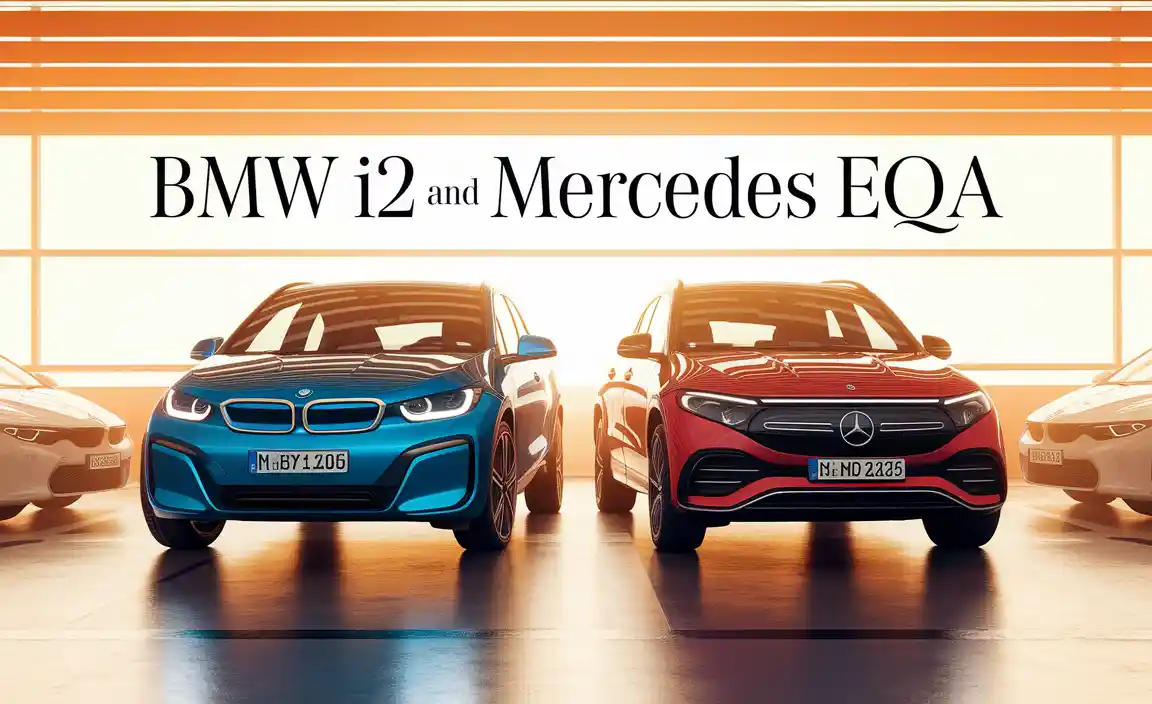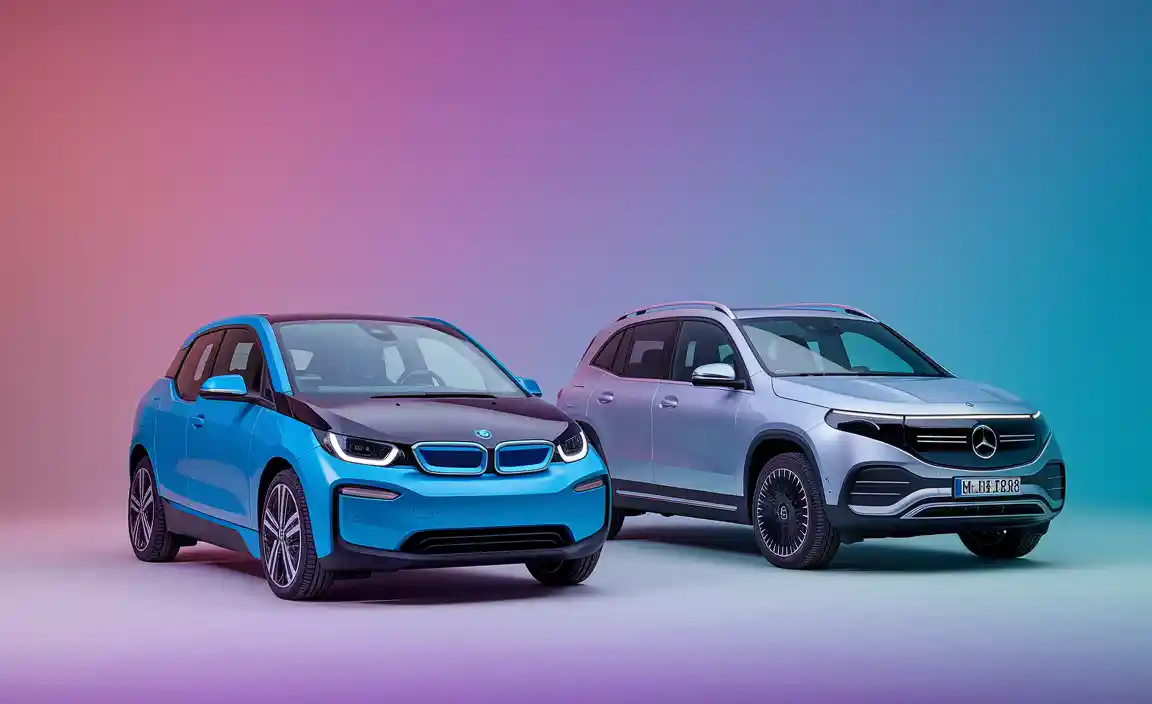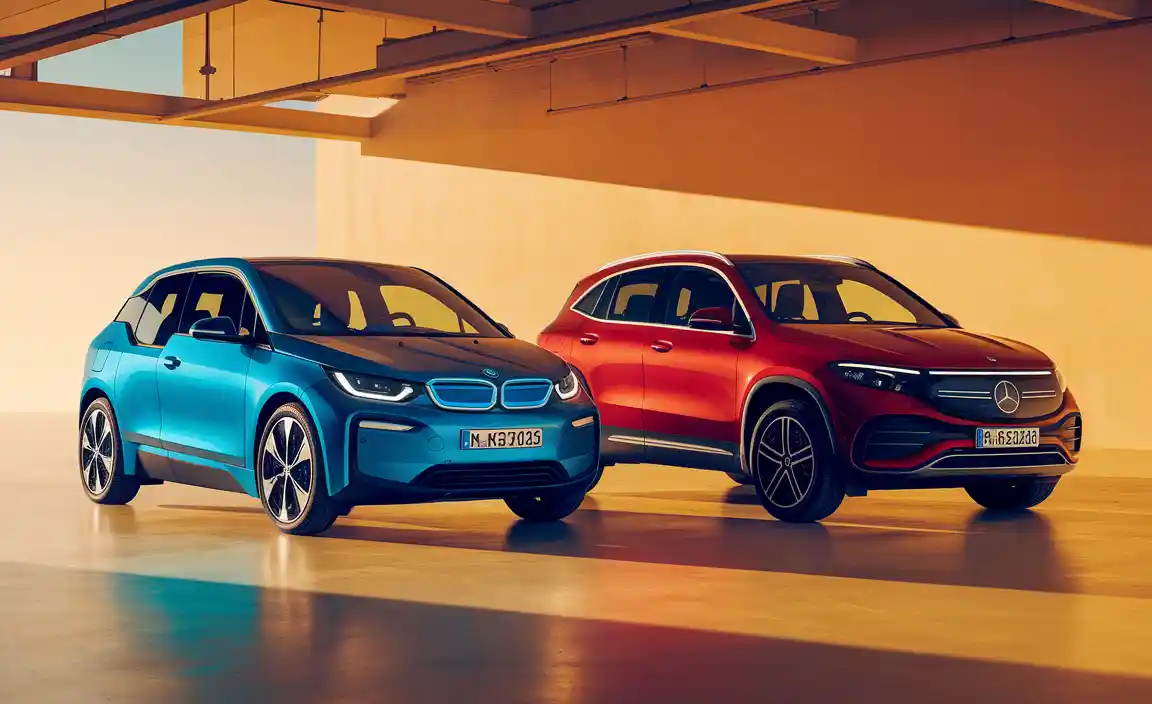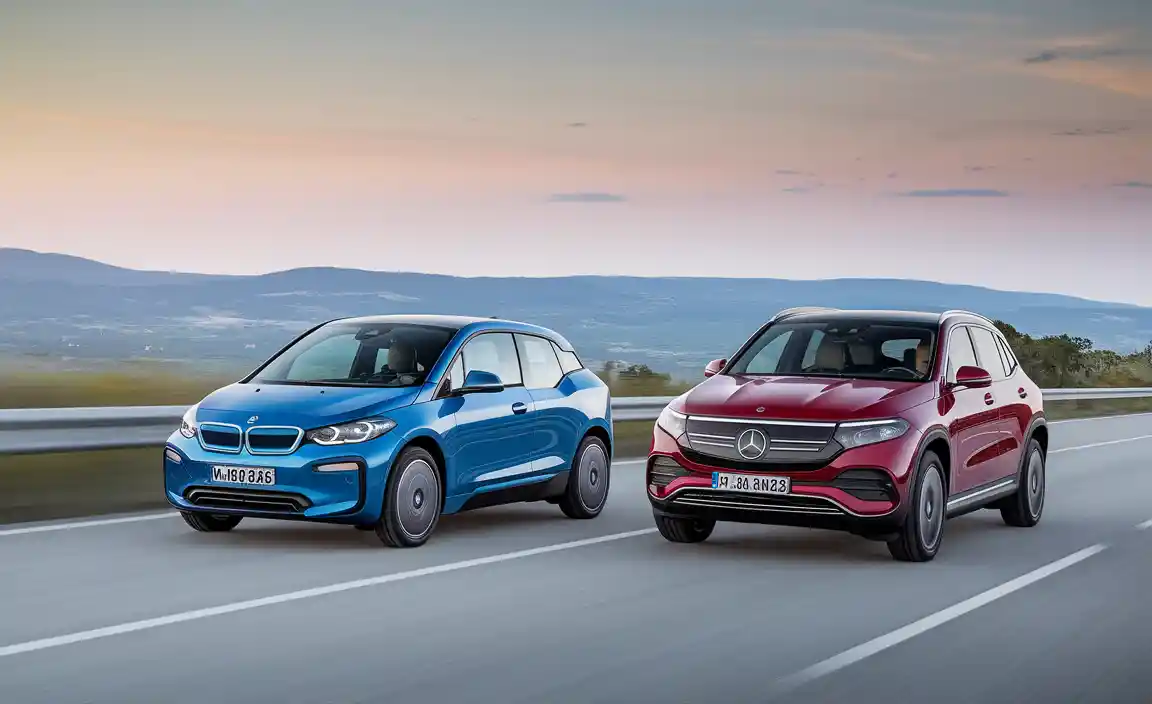Hey there! If you’ve been keeping an eye on electric vehicles lately, you’ve probably noticed two standout players in the compact EV segment — the BMW i2 and the Mercedes EQA. Both come with their own unique flavor of style, tech, and electric performance. So, which one truly wins the battle of electric style and smarts? Let’s dive deep and break it down like we’re comparing two trendy gadgets over coffee.

Choosing between the BMW i2 and the Mercedes EQA is like picking between two best friends—each one sharp, stylish, and full of surprises. But under the skin, they carry different vibes. If you’re thinking of going electric and can’t decide between these two premium compact EVs, let’s walk through it together, just like two car enthusiasts catching up over coffee.
First Impressions: Styling That Sparks Attention

BMW I2 — Quirky And Futuristic
The BMW i2 isn’t your typical compact car. It’s a bold statement in the EV world. With its distinctive angular lines, compact footprint, and innovative use of carbon fiber-reinforced plastic, the i2 screams futuristic urban mobility. The tall stance and wide doors give it a playful, almost spaceship-like vibe — it’s definitely a head-turner whether parked or zipping through city streets.
Mercedes EQA — Sophisticated And Sleek
Now, the Mercedes EQA opts for elegance and subtlety. It’s like the little sibling of the EQ family, borrowing the luxury cues from its bigger electric brothers like the EQC. With smooth curves, a bold front grille framed by signature LED lights, and a compact crossover silhouette, the EQA blends style with refinement. It looks polished and premium without shouting “I’m electric!” — more like confidently whispering it.
A Quick Peek At The BMW I2 Models
The BMW i2 isn’t just another take on the 2 Series Gran Coupe—it’s a reimagined electric version built for the modern city driver. Think gran coupe looks with EV power under the hood. You’ve got that signature kidney grille up front, but behind it lies quiet, clean energy. And yes, it’s built on the same DNA as the BMW 2 Series, so if you love the 2, the i2 is just a smarter sibling.

BMW I2 — Minimalist And Innovative
Step inside the i2, and you’re greeted by a cabin that’s as forward-thinking as its exterior. The minimalist dashboard features floating digital displays with intuitive BMW iDrive controls. The use of sustainable materials, like recycled plastics and eucalyptus wood, adds an eco-friendly charm. Space-wise, it’s surprisingly roomy for its size — perfect for city dwellers who want comfort without bulk.
Key Specifications And What They Mean In Real Life
The BMW i2 comes in single and dual motor configurations, ranging from 150 to 210 kW. That translates to zippy acceleration and smooth rides—even when you’re merging on the motorway. Battery capacity hovers around 64 kWh, offering a practical range of 265–290 miles (real-world).
Transmission type? Single-speed automatic, as expected from a modern EV.
You also get Apple CarPlay, Android Auto, and a surprisingly comfy cabin with rear AC vents, backrest tilt, and automatic climate control. It doesn’t just move smart—it feels smart.
Let’s Talk Motors And Driving Feel
The electric motor on the i2 delivers instant torque, so city driving feels snappy. Whether you’re cruising through traffic or zipping out of a tight corner, there’s always enough power without the roar of a fuel-type combustion engine.
BMW I2 Range And Efficiency
Here’s the real talk—efficiency matters. The i2 hits a sweet spot between everyday performance and respectable battery capacity. It sips power instead of gulping it. If you’ve ever worried about where to plug in, don’t. With kw DC fast charging, you can top up from 10–80% in under 30 minutes.

Mercedes-Benz EQA: Quiet Class With A Bold Badge
Now let’s turn to the Mercedes-Benz EQA, a stunning piece from the Mercedes-Benz Group. It’s technically the electric version of the GLA, but honestly, it feels like a league of its own. The Mercedes-Benz EQA brings that signature Mercedes EQ design language—sleek lines, subtle luxury, and just the right dash of futuristic glow.
What Makes The Mercedes EQA Special?
The EQA runs on a 66.5 kWh battery and offers up to 265 miles WLTP range. With the EQS SUV paving the way in electric luxury, the EQA brings that same flavor to the compact crossover world. It features bluetooth connectivity, central locking, parking sensors, and accessory power outlets right where you need them.
Mercedes Eqa — High-Tech Luxury
In the EQA, luxury takes center stage. The cabin is wrapped in soft-touch materials, with a sweeping digital cockpit that combines a large infotainment screen and digital instrument cluster seamlessly. The MBUX system (Mercedes-Benz User Experience) is one of the smartest around — it responds to voice commands naturally and even learns your habits over time. Plus, the rear seats offer decent legroom, making it more family-friendly than the i2.
BMW I2 Vs Mercedes EQA: Face-To-Face Comparison
The i2 is designed primarily for city life. It’s quick off the line thanks to its electric motor, delivering instant torque that makes city traffic a breeze. While it’s not the longest-range EV out there, it offers enough juice for daily commuting — roughly around 120-140 miles depending on the version. Its lightweight construction also means nimble handling and a fun-to-drive character.
The EQA steps up with a slightly bigger battery, pushing its range closer to 250-270 miles, which is a solid figure for a compact electric SUV. It offers smooth acceleration and a refined driving experience that balances comfort and responsiveness. All-wheel-drive versions are available, making it a bit more versatile for different driving conditions, including mild off-road or winter roads.

Charging & Practicality: How Convenient Are They?
BMW I2
Charging the i2 is pretty straightforward. It supports fast charging that can get you from 0 to 80% in about 40 minutes, ideal for quick top-ups. Its small size means it’s easy to park and maneuver in tight city spots, and the rear-hinged back doors (called coach doors) add a quirky touch but might take some getting used to.
Mercedes EQA
The EQA features rapid charging capability too, reaching 80% in roughly 30-40 minutes depending on the charger. It also benefits from Mercedes’ extensive network of connected services, including real-time navigation with charging station info and remote vehicle control via a smartphone app. The crossover shape means you get more cargo space and practicality — handy for weekend trips or groceries.
| Feature | BMW i2 | Mercedes EQA |
| Motor Output | 150–210 kW | 140–215 kW |
| Battery Capacity | ~64 kWh | 66.5 kWh |
| Range | 265–290 miles (real-world) | 260–265 miles (WLTP) |
| Interior Tech | Apple CarPlay, Android Auto | MBUX, Hey Mercedes |
| Safety | Euro NCAP 5-Star | Euro NCAP 5-Star |
| Charging Time (DC) | ~30 min (10–80%) | ~30 min (10–80%) |
| Interior Comfort | Rear AC, backrest tilt | Rear AC vents, ambient lighting |
Battery, Charging & Convenience
Both the i2 and EQA support fast charging. At most public stations, you’ll get enough juice for your commute in under 30 minutes. Want to charge at home? No problem—BMW’s Wallbox and Mercedes Me Charge both offer easy solutions that integrate with your smart home tech.
And if you’re driving through urban areas, shopping centres, or planning longer routes, the kw DC and AC fast charging options keep range anxiety off your radar.
Suspension, Brakes & Road Feel
Driving either car is a dream, but with different flavors. The i2 has a stiffer suspension system that leans sporty, ideal for twisty roads or fast highway drives. The EQA, in contrast, offers a more refined ride with brake assist and advanced stability controls—perfect for comfy cruises through town.
Interior Design And Tech
The BMW i2 feels more driver-centric. Minimalist dash, intuitive touch controls, and supportive seats. The Mercedes EQA leans toward elegance—rich lighting, premium textures, and that voice-activated “Hey Mercedes” AI that actually listens when you talk. Plus, both come with rear reading lamps and optional wireless charging trays.
Safety First
With Euro NCAP 5-star ratings on both sides, you’re in good hands. Features like door ajar warning, brake assist, rear AC vents, and collision avoidance come standard. Whether you’re in a Mercedes-Benz car or BMW i2, peace of mind comes standard.
BMW I2: What It Nails
- Snappy, torque-rich drive
- Clean, minimalist cabin
- Efficient battery capacity
- Seamless app integration
- Handles like a sports coupe
BMW I2: What It Misses
- Rear seat space is tighter
- Limited towing or cargo space
- Lacks full SUV flexibility like the ix1 LWB
Mercedes Eqa: What It Nails
- Plush interior, MBUX experience
- Great for city + occasional road trips
- Spacious rear cabin
- Smooth ride and advanced safety tech
Mercedes Eqa: What It Misses
- Slightly heavier than rivals
- Touchpad can feel distracting
- Slower acceleration than BMW i4 or ix3
Price & Ownership Experience
The BMW i2 often comes with a lower starting price, making it an attractive entry point into electric driving. However, its niche design and slightly limited practicality might not suit everyone. The Mercedes EQA, with its luxury badge and broader appeal, commands a higher price but delivers more versatility, comfort, and tech features.
Both come with strong warranty packages, and because they’re electric, you get the perks of lower running costs, tax incentives, and a quieter, cleaner ride.
So, Which One Should You Choose?
- If you want quirky style, lightweight agility, and a bold urban EV experience, the BMW i2 is your match.
- If you prefer sophisticated luxury, longer range, and more family-friendly practicality, the Mercedes EQA shines brighter.
Ultimately, it boils down to your lifestyle and what you value most in an electric car — fun and flair, or comfort and connectivity. Either way, both vehicles mark exciting steps in the EV revolution, proving that style and smarts can indeed go hand in hand.
For commuting and city life—the EQA wins on comfort, parking ease, and quiet power. Great for tight spaces, eco-conscious errands, and everyday luxury.
For longer travel and spirited drives—the BMW i2 shines with agile handling, better acceleration, and a sporty edge that mimics the 2 Series experience.
Mercedes Eqa 2024: What’s New?
- Updated grille and lighting
- Upgraded battery capacity with improved efficiency
- Tweaked MBUX interface with voice personalization
- Boosted sales prospects due to global EV demand
Compare With Similar Cars
Looking at rivals? Compare these too:
BMW Ix1 – SUV Feel, More Cargo, Same Tech
If you love BMW but want something more SUV-like than the i2, the iX1 is a solid step up. It offers similar tech — like the latest iDrive system and digital displays — but with a roomier cabin, higher seating position, and way more cargo space. It feels more grown-up and practical, especially for small families or road trips. But all that space comes with a slightly higher price and footprint.
BMW I4 – More Powerful But Pricier
The i4 is for those who crave performance. It’s a sleek electric Gran Coupé that delivers serious power and sharp handling, especially in the M50 version. Compared to the i2, it’s more of a grand tourer than a city companion. If you’re into fast lanes and long-range drives — and you’ve got a higher budget — the i4 might be worth the splurge.
Mercedes Glc Eq – More Space, Less Efficiency
Think of the GLC EQ (EQC) as the EQA’s bigger sibling. You get more room, a more commanding drive, and luxury dialed up to eleven. But it’s heavier and slightly thirstier on the battery, which means shorter range and less efficiency compared to the EQA. It’s a great pick for those who need space without leaving the Mercedes EV family.
Volvo Xc40 Recharge – Rugged Charm, Great Safety
Volvo’s XC40 Recharge feels like the cool Scandinavian in the room. It has a boxier, tougher stance than the EQA or i2, and it’s loaded with safety tech — classic Volvo. It’s also surprisingly quick, with dual-motor setups offering strong performance. The interior is practical, with a minimalist Swedish vibe. Efficiency isn’t its strongest point, but safety and style sure are.
Tesla Model Y – More Range, Less Personality
The Model Y leads the pack in raw range and charging infrastructure. It’s efficient, quick, and comes with Tesla’s legendary Supercharger access. But it can feel a bit sterile — minimal to the point of cold, and lacking the design personality of the EQA or the quirkiness of the i2. Still, for those who value tech and practicality over flair, it’s a top contender.
Kia Ev6 – Bold Looks, Solid Value
The Kia EV6 surprises many. It’s got a futuristic design that turns heads, a spacious interior, and an impressive real-world range. It also offers ultra-fast charging, beating many premium rivals. While the badge may not have the cachet of BMW or Mercedes, the value-for-money is excellent — and the tech isn’t far behind either.
Audi Q4 E-Tron – German Quality, Audi Flair
The Q4 e-tron slides in neatly between the EQA and iX1 in terms of size. It’s premium without being flashy, and the cabin quality feels unmistakably Audi — solid, stylish, and refined. It also boasts a smooth ride and smart virtual cockpit, though the infotainment isn’t as intuitive as Mercedes’ MBUX. A great pick if you’re loyal to the four rings.
Hyundai Ioniq 5 – Budget-Friendly, Reliable Ev Pioneer
Don’t overlook the Ioniq 5. It’s one of the most forward-thinking EVs on the market — with a bold pixelated design, smart cabin layout, and excellent efficiency. It’s affordable compared to the German brands, but still feels premium thanks to Hyundai’s attention to detail and tech. Great for newcomers to EVs who want reliability and style without breaking the bank.
Final Thoughts
In the end, both the BMW i2 and Mercedes EQA are exceptional examples of where premium electric cars are headed. If you want a compact hybrid feel in a full EV package, both deliver—but with different personalities.
The BMW i2 is all about the drive, while the Mercedes-Benz EQA is about the lifestyle.
And really, it’s less about specs and more about what fits your world. So whether you lean toward the BMW 2 Series sportiness or the quiet charm of the Mercedes EQ, you’re stepping into the future—with zero emissions and a lot of style.
Faqs
- What Is The Electric Range Of The BMW I2 And Mercedes EQA?
Electric range varies depending on model. The i2 delivers about 265–290 miles in real-world use, while the EQA offers up to 348 miles WLTP (EQA 250+). - How Long Does Charging Take On Each Model?
Charging time on both vehicles is similar: DC fast charging (10–80 %) takes around 30 minutes, with AC wallbox times between 3–6 hours depending on capacity. - What Are The Motor Outputs And Performance Differences?
Motor output for the i2 ranges from 150–210 kW (up to 210 hp), while the EQA 250+ has 140 kW (190 hp) and the EQA 350 4MATIC reaches up to 215 kW (292 hp); 0–62 mph times span from 8.6 s to around 6 s. - How Efficient Are These Evs?
Efficiency comes down to kWh/100 km: the i2 achieves about 15.3 kWh/100 km, and the EQA around 14.4 kWh/100 km. - How Practical Is The Interior Space And Cargo Capacity?
Interior space differs: the EQA offers 340 L of boot space (1,320 L with seats down), compared to more compact dimensions on the i2; passenger room is similar for five seats. - How Safe Are The BMW I2 And Mercedes EQA?
Safety remains top-tier: the EQA achieved 5‑star Euro NCAP, and BMW platforms are similarly rated; both offer advanced systems like blind‑spot and brake assist. - What Charging Hardware Do The Cars Use?
Charging hardware includes CCS fast charging (i2 up to 128 kW, EQA up to 100 kW) and AC onboard chargers (11 kW for i2, 9.6–11 kW for EQA). - How Do Motor And Drivetrain Layouts Compare?
Drivetrain layouts vary: the i2 is front-wheel-drive with one motor, while the EQA range includes FWD and AWD options (up to dual motors in EQA 350 4MATIC). - How Do BMW And Mercedes Work Together On These Evs?
Collaboration is in play: BMW i2 and Mercedes EQA share a common platform and components (batteries, transmissions), but retain brand-unique driving profiles. - What Updates Did The 2024 EQA Bring?
Updates include a facelift with new grille and lights, larger screens, plug‑&‑charge, and extended battery range up to 348 miles WLTP.